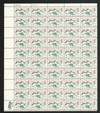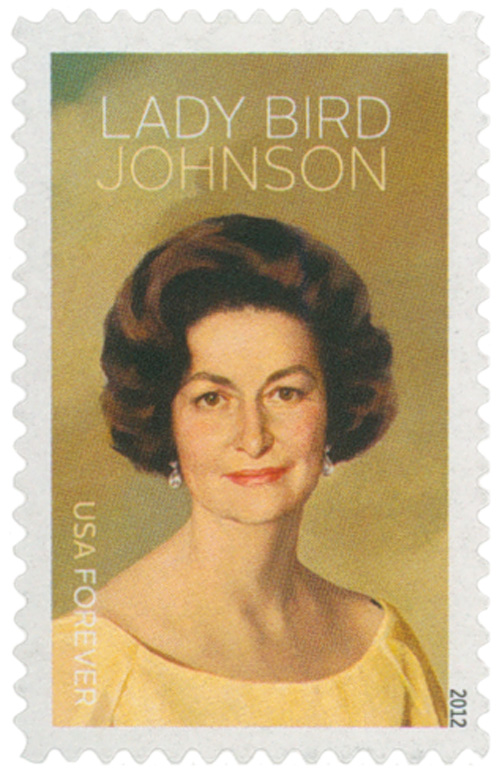
# 1318 - 1966 5c Beautification of America
Quantity: 128,460,000
First Lady Johnson was born on December 22, 1912, in Karnack, Texas.
Born Claudia Alta Taylor, the future Mrs. Johnson was nicknamed "Lady Bird" by her nurse, who said she was as purty as a lady bird. The daughter of a successful cotton planter and one of the largest landowners in the county, Lady Bird had a privileged childhood. She spent time in the fields of wildflowers surrounding her East Texas home, instilling an appreciation of nature that continued throughout her life.
Lady Bird was also a bright young woman, graduating third in her high school class at just 15 years old. She studied journalism at the University of Texas at Austin and graduated with honors. She planned to embark on a career in journalism or writing, but met Lyndon Johnson ten weeks after graduation and the couple began their whirlwind romance.
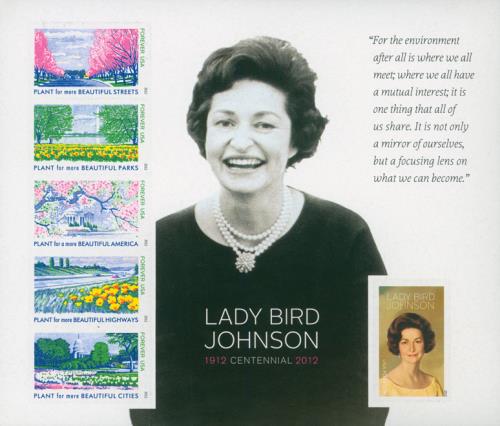
Lady Bird and Lyndon married in November 1934, only three months after they met. In 1937, Lyndon made his first run for U.S. Congress. Three years later, Lyndon volunteered for a Navy command, leaving Lady Bird to run his congressional office. After Johnson's six terms in Congress, he was elected to the Senate, but suffered a heart attack shortly after. Insisting that his recovery was more important than work, Lady Bird managed his aides and decided what issues to bring to him.
In 1960, Johnson accepted John F. Kennedy's request to serve as Presidential running mate. Lady Bird campaigned actively, filling in for the pregnant Jackie Kennedy, often with little notice. She called the Democratic Party the "party with heart" and traveled some 35,000 miles in 71 days. After Kennedy and Johnson won the election, she continued to fill in for Jackie when needed and traveled extensively with her husband.
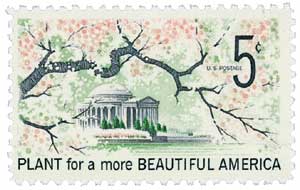
In November 1963, Lady Bird and Lyndon rode in the car behind President Kennedy when he was shot by an assassin. She comforted Jackie and promised to carry out the projects she had initiated, largely pertaining to the preservation of White House relics. Lady Bird had a major influence on her husband’s policies and decisions. She helped him edit his speeches and listened keenly to the issues that interested her, most notably the beautification of America and its highways.
Lyndon and Lady Bird Johnson traveled across America while campaigning for the 1964 election. At a stop in Oregon, Mr. Johnson told the audience the unsightly junkyards and billboards along the roads "are driving my wife mad." This trip and speech inspired Lady Bird in her most famous undertaking: the Highway Beautification Act. She employed her quiet Southern charm to influence legislators and the media to see the importance of beautifying the country. Though the act was met with significant opposition, particularly from businesses who would lose valuable advertising space, the First Lady was very convincing and would not back down. Her diligence paid off, and the act, nicknamed "Lady Bird's Bill", passed in 1965. With the passage of this bill, the amount of junkyards and billboards along highways were drastically reduced, making room for artistic landscaping and wildflowers in bloom.
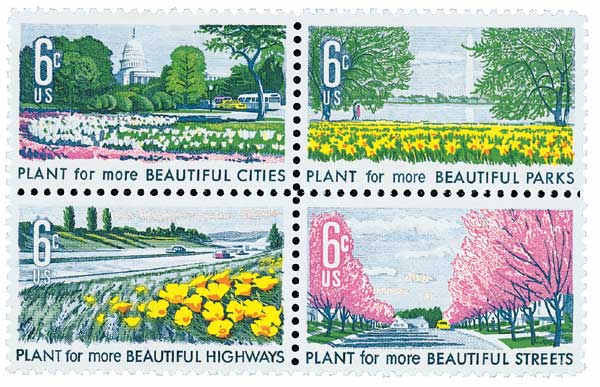
Lady Bird also focused on improving the nation's capitol. When she arrived in Washington, she found it uninviting to residents and tourists. The First Lady wanted to make The National Mall more attractive and called for volunteers to begin replacing a dispirited sprig of grass with shrubs and flowers. Thousands of trees and plants were added, including two million daffodil bulbs planted in just four years. Part of these programs also included fixing up schools, building recreation areas, and renovating old buildings.
Lady Bird was outspoken on both the rights of women and minorities, and was the only woman present when her husband signed the Civil Rights Act. She stressed the importance of racial integration and embarked on a speaking tour, even after threats were made on her life. Lady Bird convinced her husband not to run for another term and they retired to Texas, though she remained extremely busy. She carried out new beautification projects in her home state, served as a regent of the University of Texas, and was awarded the Medal of Freedom and Congressional Gold Medal. Lady Bird also helped establish the National Wildflower Research Center. One of her final generous acts before her passing in 2007 was donating $300,000 to her church to help pay off its mortgage.
Quantity: 128,460,000
First Lady Johnson was born on December 22, 1912, in Karnack, Texas.
Born Claudia Alta Taylor, the future Mrs. Johnson was nicknamed "Lady Bird" by her nurse, who said she was as purty as a lady bird. The daughter of a successful cotton planter and one of the largest landowners in the county, Lady Bird had a privileged childhood. She spent time in the fields of wildflowers surrounding her East Texas home, instilling an appreciation of nature that continued throughout her life.
Lady Bird was also a bright young woman, graduating third in her high school class at just 15 years old. She studied journalism at the University of Texas at Austin and graduated with honors. She planned to embark on a career in journalism or writing, but met Lyndon Johnson ten weeks after graduation and the couple began their whirlwind romance.

Lady Bird and Lyndon married in November 1934, only three months after they met. In 1937, Lyndon made his first run for U.S. Congress. Three years later, Lyndon volunteered for a Navy command, leaving Lady Bird to run his congressional office. After Johnson's six terms in Congress, he was elected to the Senate, but suffered a heart attack shortly after. Insisting that his recovery was more important than work, Lady Bird managed his aides and decided what issues to bring to him.
In 1960, Johnson accepted John F. Kennedy's request to serve as Presidential running mate. Lady Bird campaigned actively, filling in for the pregnant Jackie Kennedy, often with little notice. She called the Democratic Party the "party with heart" and traveled some 35,000 miles in 71 days. After Kennedy and Johnson won the election, she continued to fill in for Jackie when needed and traveled extensively with her husband.

In November 1963, Lady Bird and Lyndon rode in the car behind President Kennedy when he was shot by an assassin. She comforted Jackie and promised to carry out the projects she had initiated, largely pertaining to the preservation of White House relics. Lady Bird had a major influence on her husband’s policies and decisions. She helped him edit his speeches and listened keenly to the issues that interested her, most notably the beautification of America and its highways.
Lyndon and Lady Bird Johnson traveled across America while campaigning for the 1964 election. At a stop in Oregon, Mr. Johnson told the audience the unsightly junkyards and billboards along the roads "are driving my wife mad." This trip and speech inspired Lady Bird in her most famous undertaking: the Highway Beautification Act. She employed her quiet Southern charm to influence legislators and the media to see the importance of beautifying the country. Though the act was met with significant opposition, particularly from businesses who would lose valuable advertising space, the First Lady was very convincing and would not back down. Her diligence paid off, and the act, nicknamed "Lady Bird's Bill", passed in 1965. With the passage of this bill, the amount of junkyards and billboards along highways were drastically reduced, making room for artistic landscaping and wildflowers in bloom.

Lady Bird also focused on improving the nation's capitol. When she arrived in Washington, she found it uninviting to residents and tourists. The First Lady wanted to make The National Mall more attractive and called for volunteers to begin replacing a dispirited sprig of grass with shrubs and flowers. Thousands of trees and plants were added, including two million daffodil bulbs planted in just four years. Part of these programs also included fixing up schools, building recreation areas, and renovating old buildings.
Lady Bird was outspoken on both the rights of women and minorities, and was the only woman present when her husband signed the Civil Rights Act. She stressed the importance of racial integration and embarked on a speaking tour, even after threats were made on her life. Lady Bird convinced her husband not to run for another term and they retired to Texas, though she remained extremely busy. She carried out new beautification projects in her home state, served as a regent of the University of Texas, and was awarded the Medal of Freedom and Congressional Gold Medal. Lady Bird also helped establish the National Wildflower Research Center. One of her final generous acts before her passing in 2007 was donating $300,000 to her church to help pay off its mortgage.








